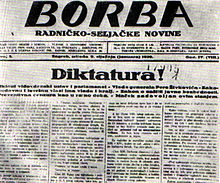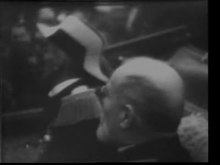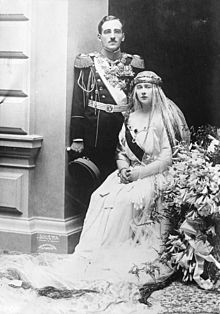Alexander I (Yugoslavia)
Alexander I Karadjordjevic ( Serbian Aleksandar Karadjordjevic I. , Serbian - Cyrillic Краљ Александар I Карађорђевић even Aleksandar Ujedinitelj ( "The Unifier"); December 4 . Jul / 16th December 1888 greg. In Cetinje , Principality of Montenegro ; † 9 October 1934 in Marseille , France ) was Prince Regent of Serbia from 1914 to 1918 and King of the Serbs, Croats and Slovenes from 1921 to 1934 . He came from theHouse Karađorđević . In 1929 he repealed the constitution, proclaimed the royal dictatorship and renamed the country the Kingdom of Yugoslavia . Alexander died in an assassination attempt.
Life
Childhood and youth
Prince Alexander of Serbia was born on December 4th . / December 16, 1888 greg. Born in the Montenegrin Cetinje . He was the fourth descendant and second son of the exiled Serbian Prince Peter Karađorđević and his wife Zorka of Montenegro , daughter of Prince Nikola of Montenegro .
Alexander spent his youth in Montenegro, and in 1894 his widowed father went to Switzerland with the children who completed their schooling there. Together with his older brother Prince Georg , he then received military training at the page corps in Saint Petersburg . After the overthrow of the Obrenović dynasty as a result of a coup by insurgent officers in May 1903, his father was proclaimed the new King of Serbia as Peter I , and Alexander returned with him from exile.
Time as crown prince
On March 27, 1909, Alexander's older brother Georg was declared insane and his rights to the throne were revoked in favor of his younger brother.
As commander in chief of the Serbian 1st Army, Crown Prince Alexander took part in the two Balkan Wars in 1912/13 .
When Peter I withdrew from the management of official business due to illness, Alexander was appointed Prince Regent on June 24, 1914 and thus the acting deputy of the father, who however retained the title of king. In this capacity, Alexander was nominal commander in chief of the Serbian armed forces during the First World War , but left the strategic warfare to the respective chief of staff (including Radomir Putnik , Petar Bojović and Živojin Mišić ). In 1915 the Serbian government moved its seat into exile on the Greek island of Corfu , as the country itself was occupied by Austro-Hungarian troops. Only towards the end of the First World War did the Serbian government return to Belgrade in 1918 .
In 1917, Prince Regent Alexander dared to condemn the 1903 coup leader and influential military intelligence chief Colonel Dragutin Dimitrijević (known as Apis ) as a traitor and have him executed. This eliminated a dangerous political rival who had organized the assassination of the Austro-Hungarian heir to the throne Franz Ferdinand from Belgrade in 1914 .
On December 1, 1918, in Belgrade, Alexander proclaimed the union of Serbia with the southern Slavic countries of Austria-Hungary to form the Kingdom of Serbs, Croats and Slovenes . At the same time he returned as regent and handed over the official duties to his father King Peter again. However, the Crown Prince remained very influential politically.
The domestic politics of the new state were marked by growing conflicts between the nationalities. While the Serbian side viewed the new state as a direct continuation of the Kingdom of Serbia and advocated a centralized constitution, Croatians and Slovenes demanded greater autonomy for the individual sub-areas. The Croatian Peasant Party under Stjepan Radić initially rejected the monarchical form of government as such, as did the Communist Party of Yugoslavia , which was soon banned.
Domination
After his father's death on August 16, 1921 Alexander was when Alexander I for the second King of the Serbs, Croats and Slovenes .
In contrast to his father, who had largely stayed out of day-to-day politics before the war and thus enabled the development of a parliamentary system of government in the Kingdom of Serbia, Alexander intervened directly in government policy from the start. Like the leading Serbian politicians, he advocated a centralized and monarchical state order, as enshrined in the constitution of June 28, 1921. At the same time, however, he tried at their expense to expand his own position of power and to weaken the position of the most important Serbian party, the Radical Party led by the multiple Prime Minister Nikola Pašić . In doing so, he relied primarily on circles of the Serbian officer corps, with whom he was personally known from his time in the army and who were also known as camarilla .
In foreign policy, Alexander sought alliances with France as well as with Romania and Czechoslovakia in order to secure the international order that emerged in east-central and south-eastern Europe after the First World War and thus ultimately the continued existence of his empire, which was only established in 1918, against possible revision efforts. This led to the formation of the Little Entente ( Kingdom of Serbs, Croats and Slovenes , Romania and Czechoslovakia) in 1921 .
Royal dictatorship
Due to the political contradictions between centralist and federalist forces as well as among mostly ruling centralists themselves, no stable government supported by a parliamentary majority came into existence during the 1920s. After the chairman of the Croatian Peasant Party and opposition leader Stjepan Radić was shot dead in 1928 by the Serbian nationalist MP Puniša Račić , who came from Montenegro, in the Belgrade parliament, the opposition Croatian MPs refused to continue attending the parliamentary sessions, and voices increased questioned the continued existence of the existing state system.

In this situation, Alexander I carried out a coup on January 6, 1929 . He suspended the 1921 constitution, dissolved parliament and proclaimed the royal dictatorship . The new government initially consisted largely of his personal confidants. Finally, on October 3, 1929, he ordered the renaming of the state to Kraljevina Jugoslavija (Kingdom of Yugoslavia). As part of an administrative reform, the country was divided into Banovine (banks), which deliberately intersected the borders of the historical parts of the country and were named after rivers, following the example of the French departments . The use of the popular names ( Serbs , Croats and Slovenes ) for political purposes was forbidden, and in future all residents should only consider themselves “Yugoslavs”.
Alexander I justified his approach by saying that he had to save the unity of the state, something the politicians of the traditional parties had proven to be incapable of.
The introduction of the royal dictatorship initially met with no direct resistance. The federalist opposition, too, initially waited for further developments, as it was entirely in agreement with the repeal of the centralist constitution of 1921, which it had always opposed. After it became clear, however, that Alexander wanted to maintain the centralized state order and rule with the help of Serb officers, he met growing resistance, especially among the Croatians. While the Croatian Peasant Party, under its new chairman Vladko Maček, advocated peaceful internal opposition, Ante Pavelić , previously chairman of an ultra-nationalist Croat splinter party, founded the Ustasha movement in exile in Italy and called for a violent overthrow in Yugoslavia. He was supported by the Italian dictator Mussolini , who was interested in weakening Yugoslavia, which he viewed as rivals for supremacy on the Adriatic . The Ustaša initially carried out individual attacks and then tried to start a real uprising from 1932 to 1933, which failed due to a lack of popular support. The government reacted to the Ustasha's activities by forcibly suppressing any potential resistance. Several members of the opposition who were not involved in the terrorist activities, including Milan Šufflay , were murdered by agents of the Yugoslav secret service, which sparked international protests.
In 1931 Alexander I announced a new constitution. However, only parties that could run candidates across the country were allowed to participate in the parliamentary elections that followed, and the strongest party was given clear preference in the election. On the part of the government, a Yugoslav unity party was founded, in which, in addition to some members of the old Serbian parties, some leading politicians from the Slovenes and Bosnian Muslims took part, while the Croatian Peasant Party, by far the largest Croatian political force, remained in the opposition. Since a nationwide opposition list did not come about, the first parliamentary elections under the new constitution turned into a farce. In fact, Alexander I and the circles of the military who supported him still united all power in the state in their hands.
Assassination and death
In order to overthrow the regime, the Ustasha movement under Ante Pavelić planned the assassination of Alexander in cooperation with the IMRO and presumably with the support of the Italian foreign intelligence service . To this end, she sent several murder squads to France , where Alexander was expected for a state visit.
On October 9, 1934, the king visited Marseille . Although the French police and the Yugoslav consulate warned the king of a possible assassination attempt , Alexander wanted to carry out the visit as planned. So he left the destroyer Dubrovnik, lying in the harbor, at around 4 p.m. and met the French Foreign Minister Louis Barthou on land . Together with Barthou and the French general Alphonse Georges , he took a seat in the back of a landaulet with the top down. According to a source, it was the Delage Type DM with serial number 29,610. The vehicle was first registered in Seine-et-Oise on July 13, 1933 . On December 13th of the same year it was bought by Charles Cornet from Marseille, who ran a workshop there together with Georges Perini. The vehicle received the license plate number 6068 CA 6 . On certain occasions, the vehicle was loaned to authorities. In another source, however, a Delage Type D.8 is mentioned.
The car had only traveled 100 meters at walking pace when the assassination attempt broke out. The Bulgarian assassin Wlado Chernosemsky shot the king and the foreign minister before he was seriously wounded with a sword blow by a French officer. He died that same evening from numerous injuries inflicted on him by angry onlookers and police officers.
Alexander I died a few minutes after the attack in the prefecture of Marseille. During the forensic examination of Alexander's corpse, it was found that the king had died from a shot in the back. It is therefore not excluded that he was killed by a bullet from one of his own bodyguards. He was transferred to Serbia and buried in Topola .
Almost all of the assassination attempt on Alexander I was filmed. The Fox Movietone cameraman turned the camera on when the first shots were fired (out of about 10 total). The car came to a stop close in front of this camera.
The French government did not want an open conflict with Italy and therefore put strong pressure on the Yugoslav government. In doing so, she achieved that the king's widow waived her secondary complaint in the trial against the assassin's arrested accomplices.
Since his son Peter II was still a minor, Pavle Karađorđević , the only son of Aren Karađorđević, the younger brother of Alexander's father Peter I, took over the rule of the Yugoslav kingdom as regent. Peter II. Was about to raid the German Reich declared on Yugoslavia in April 1941 for an adult and took up office until he was forced to flee into exile. He was the last king of Yugoslavia.
Marriage and offspring
On June 8, 1922, he married Maria of Romania , a daughter of the Romanian King Ferdinand I of the House of Hohenzollern-Sigmaringen and his wife Marie of Edinburgh .
The connection resulted in three descendants:
- Peter (1923–1970), as Peter II. ∞ Alexandra of Greece
- Tomislav (1928–2000) ∞ Margarete von Baden
- Andreas (1929–1990) ∞ Christina Margarethe von Hessen-Kassel
Commemoration
The King Alexander Bridge in Belgrade is named after him.
literature
- Vladeta Milićević : The regicide of Marseille: The crime and its background . Hohwacht-Verlag, Bad Godesberg 1959 (new edition in Serbian: Ubistvo kralja u Marselju: pozadina jednog zločina . Publisher “Filip Višnjić”, Beograd 2000. ISBN 8673632587 ).
- Stephen Graham: Alexander of Yugoslavia: The Story of the King Who Was Murdered at Marseilles . Gazelle Book Services Ltd, 1972.
- Edgar Hösch: Alexander I. Karadjordjević . In: Biographical Lexicon on the History of Southeast Europe . Volume 1. Munich 1974, pp. 35-37
Web links
- Newspaper article about Alexander I in the 20th century press kit of the ZBW - Leibniz Information Center for Economics .
Individual evidence
- ^ Daniel Cabart, Claude Rouxel, David Burgess-Wise: Delage. France's Finest Car . Volume 1. Dalton Watson, Deerfield 2007, ISBN 978-1-85443-219-3 , pp. 274 (English).
- ↑ Chroniques marseillaises des années trente (French, accessed February 8, 2020)
| predecessor | Office | successor |
|---|---|---|
| Peter I. |
King of Serbs, Croats and Slovenes from 1929 King of Yugoslavia 1921–1934 |
Peter II |
| personal data | |
|---|---|
| SURNAME | Alexander I. |
| ALTERNATIVE NAMES | Alexander I. Karaorđević; Aleksandar I. Karađorđević (Serbian); Aleksandar Ujedinitelj |
| BRIEF DESCRIPTION | King of Yugoslavia (1921–1934) |
| DATE OF BIRTH | December 16, 1888 |
| PLACE OF BIRTH | Montenegro |
| DATE OF DEATH | October 9, 1934 |
| Place of death | Marseille |






